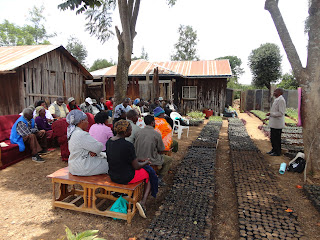By James Maina
Residents of
Olmoran ward Laikipia County turned up in large numbers to conserve the environment Wednesday. The day was marked with a road show from Lariak Primary
school to Mlima meza (Flat topped hill) where pupils parrents and teachers planted trees and climbed up the hill to view the landscape. Few trees were planted due to scarce rains, but there are enough seedlings to be planted when enough
rain sets in. Laikipia is currently witnessing a spate of dry spells. The aim
of the event was to conduct sensitization on climate change to avert global
warming.
The activity
was sponsored by Tree is Life Trust (TILT) an NGO which deals with
environmental conservation. The organization has been championing planting of
trees in schools, hospitals and other public places and also promoting the use of renewable sources of energy. Other organizations which
graced the occasions were ALIN, CFA, WRUA, BUNDELL and government departments.
The event kicked off with a procession which started at Lariak primary
school with over five hundred people participating. Pupils and students from
the neighboring schools and members of the public participated in the awareness
creation event. The procession snaked through the streets of Sipili market
before matching to Mlima Meza. This
historical hill stands near Sipili primary school about 5 kilometers away from Sipili
market.
Pupils of
Bondeni, Sipili, Lariak and Machunguru primary schools told Ngarua Maarifa Centre (NMC) that they
have learnt good lessons on conserving and protecting the environment. James
Kariuki a pupil in Sipili primary school said, “The ball is now on our bay. I need to plant a
tree every week and care for the existing ones here in school and at home.” Others
who were contacted by NMC were students and teachers from the participating
schools. Members of the public planted
seedlings at the foot of the hill while pupils helped in watering them.
The day
culminated in speeches from representatives of different groups. Speakers
emphasized on the need to protect environment for posterity. They
were concerned with sporadic cutting of trees and clearing of thickets which
has led to fluctuating weather conditions. Residents were asked to take
personal responsibility to avoid the wrath of Mother Nature. Laikipia is known
for agricultural productivity but recently farming has been hampered by poor
rainfall.






